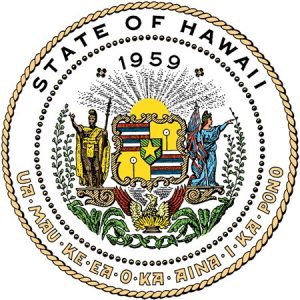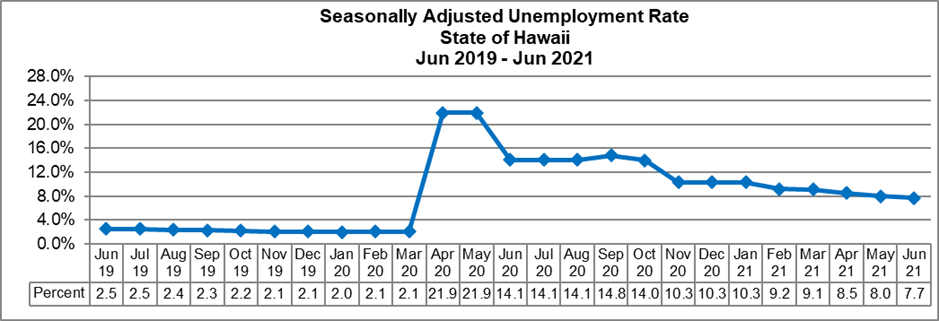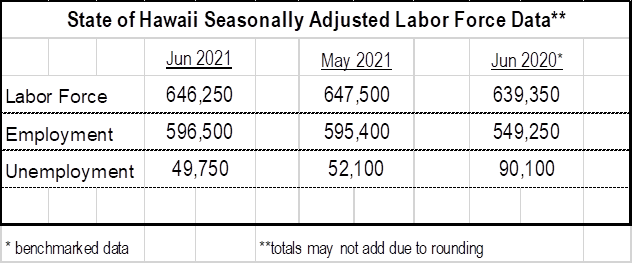Hawai‘i’s Unemployment Rate at 7.7 Percent in June
Posted on Jul 19, 2021 in NewsDEPARTMENT OF BUSINESS, ECONOMIC DEVELOPMENT & TOURISM
DAVID Y. IGE
GOVERNOR
MIKE MCCARTNEY
DIRECTOR
FOR IMMEDIATE RELEASE
July 15, 2021
HAWAI‘I’S UNEMPLOYMENT RATE AT 7.7 PERCENT IN JUNE
Jobs increased by 41,900 over-the-year
HONOLULU — The Hawai‘i State Department of Business, Economic Development & Tourism (DBEDT) today announced that the seasonally adjusted unemployment rate for June was 7.7 percent compared to the revised rate of 8.0 percent in May. Statewide, 596,500 were employed and 49,750 unemployed in June for a total seasonally adjusted labor force of 646,250. Nationally, the seasonally adjusted unemployment rate was 5.9 percent in June, up from 5.8 percent in May.
The unemployment rate figures for the State of Hawai‘i and the U.S. in this release are seasonally adjusted, in accordance with the U.S. Bureau of Labor Statistics (BLS) methodology.
The not seasonally adjusted rate for the State was 7.9 percent in June, compared to the revised rate of 7.4 percent in May.
Industry Payroll Employment (Establishment Survey)
In a separate measure of employment, total nonagricultural jobs increased by 3,000 in June over May. Job gains were experienced in Leisure & Hospitality (+2,500), Construction (+1,000), Trade, Transportation, & Utilities (+600), Other Services (+500), and Information (+300). For the third straight month, expansion in Leisure & Hospitality was robust in both Accommodation and Food Services & Drinking Places. Job losses occurred in Manufacturing (-100), Financial Activities (-100), Professional & Business Services (-200), and Education & Health Services (-1,300). Contraction in Education & Health Services was solely within the Health Services subsector, specifically in Ambulatory Health Care Services and Hospitals. Government employment declined by 200 jobs. Over-the-year (June 2020 was the 3rd month of pandemic effects), nonfarm jobs have risen by 41,900, or 8.0 percent. However, in comparison with March 2020 (last month prior to pandemic effects), nonfarm jobs were down by 86,400, or -13.2 percent.
Technical Notes
Seasonal Adjustment
The seasonal fluctuations in the number of employed and unemployed persons reflect hiring and layoff patterns that accompany regular events such as the winter holiday season and the summer vacation season. These variations make it difficult to tell whether month-to-month changes in employment and unemployment are due to normal seasonal patterns or to changing economic conditions. Therefore, the BLS uses a statistical technique called seasonal adjustment to address these issues. This technique uses the history of the labor force data and the job count data to identify the seasonal movements and to calculate the size and direction of these movements. A seasonal adjustment factor is then developed and applied to the estimates to eliminate the effects of regular seasonal fluctuations on the data. Seasonally adjusted statistical series enable more meaningful data comparisons between months or with an annual average.
Current Population (Household) Survey (CPS)
A survey conducted for employment status in the week that includes the 12th day of each month generates the unemployment rate statistics, which is a separate survey from the Establishment Survey that yields the industry job counts. The CPS survey contacts approximately 1,000 households in Hawai‘i to determine an individual’s current employment status. Employed persons consist of: 1) all persons who did any work for pay or profit during the survey reference week, 2) all persons who did at least 15 hours of unpaid work in a family-owned enterprise operated by someone in their household, and 3) all persons who were temporarily absent from their regular jobs, whether they were paid or not. Persons considered unemployed are ones that do not have a job, have actively looked for work in the prior four weeks and are available for work. Temporarily laid off workers are counted as unemployed, whether they have engaged in a specific job seeking activity. Persons not in the labor force are those who are not classified as employed or unemployed during the survey reference week.
Benchmark Changes to Local Area Unemployment Statistics Data
Statewide and substate data for 2010-2020 have revised inputs and have been re-estimated to reflect revised population controls and model re-estimation.
Change to Monthly Employment Estimates
This release incorporates revised job count figures for the seasonally adjusted series. The revised data reflects historical corrections applied to unadjusted super sector or sector level series dating back from 2004 through 2020. For years, analysts with the State DLIR’s Research and Statistics Office have developed monthly employment estimates for Hawai‘i and our metropolitan areas. These estimates were based on a monthly survey of Hawai‘i businesses and analysts’ knowledge about our local economies. Beginning with the production of preliminary estimates for March 2011, responsibility for the production of State and metropolitan area (MSA) estimates was transitioned from individual state agencies to the U.S Bureau of Labor Statistics (BLS).
For Hawai‘i, this means the transition of statewide, Honolulu and Kahului-Wailuku-Lahaina MSA estimates for both the seasonally adjusted and not seasonally adjusted areas are produced by BLS. State agencies will continue to provide the BLS with information on local events that may affect the estimates, such as strikes or large layoffs/hiring at businesses not covered by the survey and to disseminate and analyze the Current Employment Statistics (CES) estimates for local data users. BLS feels this change is designed to improve the cost efficiency of the CES program and to reduce the potential bias in state and area estimates. A portion of the cost savings generated by this change is slated to be directed towards raising survey response rates in future years, which will decrease the level of statistical error in the CES estimates. Until then, state analysts feel this change could result in increased month-to-month variability for the industry employment numbers particularly for Hawai‘i’s counties and islands. BLS can be reached at (202) 691-6533 for any questions about these estimates.
The not seasonally adjusted job estimates for Hawai‘i County, Kauai County, Maui Island, Molokai, and Lanai are produced by the State of Hawai‘i Department of Labor & Industrial Relations.
Seasonally Adjusted Labor Force & Unemployment Estimates for Honolulu & Maui Co.
BLS publishes smoothed seasonally adjusted civilian labor force and unemployment estimates for all metropolitan areas, which includes the City and County of Honolulu and Maui County. BLS releases this data each month in the Metropolitan Area Employment and Unemployment news release. The schedule is available at http://www.bls.gov/news.release/metro.toc.htm.
Alternative Measures of Labor Underutilization

The six alternative labor underutilization state measures based on the Current Population Survey (CPS) and compiled on a 4-quarter moving average basis defined:
U-1, persons unemployed 15 weeks or longer, as a percent of the civilian labor force;
U-2, job losers and persons who completed temporary jobs, as a percent of the civilian labor force;
U-3, total unemployed, as a percent of the civilian labor force (this is the definition used for the official unemployment rate);
U-4, total unemployed plus discouraged workers, as a percent of the civilian labor force plus discouraged workers;
U-5, total unemployed, plus discouraged workers, plus all other marginally attached workers*, as a percent of the civilian labor force plus all marginally attached workers; and
U-6, total unemployed, plus all marginally attached workers, plus total employed part time for economic reasons, as a percent of the civilian labor force plus all marginally attached workers.
* Individuals who want, and are available for work, and who have looked for a job sometime in the prior 12 months (or since the end of their last job if they held one within the past 12 months), but were not counted as unemployed because they had not searched for work in the four weeks preceding the survey, for such reasons as child care or transportation problems, for example. Discouraged workers are a subset of the marginally attached.
Note that, the state unemployment rates (U-3) that are shown are derived directly from the CPS. As a result, these U-3 measures may differ from the official state unemployment rates for the latest 4-quarter period. The latter are estimates developed from statistical models that incorporate CPS estimates, as well as input data from other sources, such as state unemployment claims data.
# # #
Media Contact:
Dr. Eugene Tian
Research and Economic Analysis Division
Department of Business, Economic Development & Tourism
(808) 586-2470
eugene.x.tian@hawaii.gov
dbedt.Hawaii.gov/economic/
Charlene Chan
Department of Business, Economic Development and Tourism
(808) 824-0134
charlene.l.chan@hawaii.gov
https://dbedt.hawaii.gov





